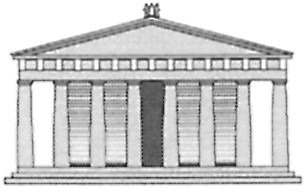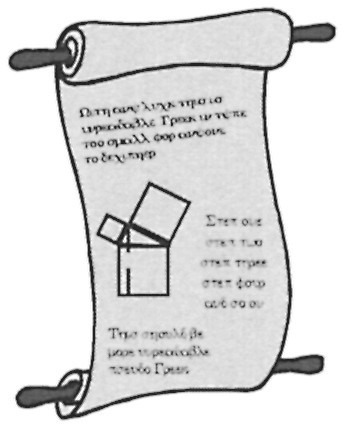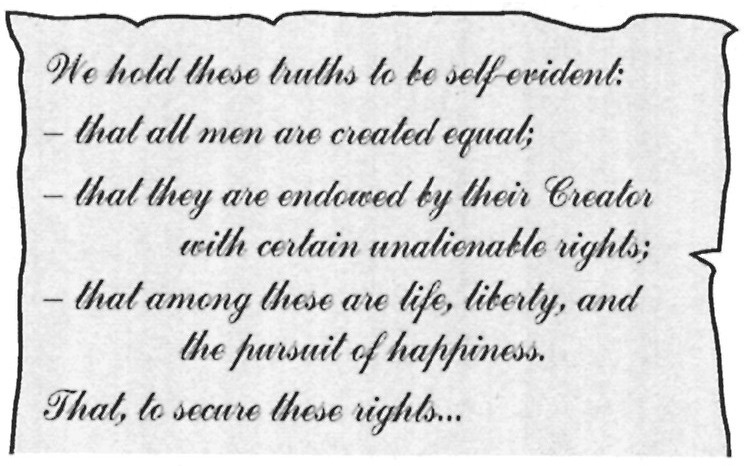
| 14 | On Beauty Bare Euclid's Plane Geometry |
Euclid alone has looked on beauty bare," wrote poet Edna St. Vincent Millay in her Sonnet xlv. Why would an artist claim that a mathematician has been the only one to really perceive beauty? One of our goals in writing this sketch is to give you some idea of how to answer that question.
About 2300 years ago in Alexandria, a Greek city near the mouth of the Nile in Egypt, a teacher named Euclid created the world's most famous axiomatic system. His system was studied by Greek and Roman scholars for a thousand years, then translated into Arabic around 800 A.D. and studied by Arab scholars, too. It became the standard for logical thinking throughout medieval Europe. It has been printed in more than 2000 different editions since it first appeared as a typeset book in the 15th century. That system is Euclid's description of plane geometry, and its story really begins at least 300 years before Euclid was born.
According to Greek historians, geometry as a logical discipline began with Thales, a wealthy Greek merchant of the 6th century B.C. They describe him as the first Greek philosopher and the father of geometry as a deductive study. Rather than relying on religion and mythology to explain the natural world, Thales began the search for unifying rational explanations of reality. His search for an underlying unity in geometric ideas led him to investigate logical ways to derive some geometric statements from others. The statements themselves were well known, but the process of linking them with logic was new. The Pythagoreans and other Greek thinkers continued the logical development of geometric principles.
By Euclid's time, the Greeks had developed a lot of mathematics, virtually all of it related to geometry or number theory. The work of Pythagoras and his followers had been around for two centuries, and many other people had written about their own mathematical discoveries, too. Plato's philosophy and Aristotle's logic were firmly established by then, so scholars knew that mathematical facts should be justified by reason. Many of these mathematical results had been proved from apparently more basic ideas. But even these proofs were disorganized, each one starting from its own assumptions, without much regard for consistency.

Building on this earlier work, Euclid organized and extended a large portion of what the Greek mathematicians had learned. One of his purposes seems to have been to put Greek mathematics on a unified, logical foundation. Euclid set out to rebuild those fields "from the ground up." He wrote an encyclopedic work called the Elements, separated into thirteen parts called "books"' (each one probably corresponding to a long papyrus scroll):
— Books I, II, III, IV, and VI are about plane geometry;
— Books XI, XII, and XIII are about solid geometry;
— Books V and X are about magnitudes and ratios; and
— Books VII, VIII, and IX are about whole numbers and their ratios.
These books contained a total of 465 "propositions" (we might call them theorems), each one proved from statements coming before it. The style of presentation is very formal and dry. There is no discussion or motivation. After the statement of each proposition is a figure to which it refers, followed by a detailed proof. The proofs end with a restatement of the proposition "which was to be proved." The Latin translation of that phrase, "quod erat demonstrandum," is the source for the abbreviation Q.E.D. that still often appears at the end of formal proofs.

Euclid paid special attention to geometry. As Aristotle had already pointed out, a logical system must begin with a few basic assumptions that we take for granted and on which we build. So, after giving a long list of definitions, Euclid specified a small number of basic statements that appeared to capture the essential properties of points, lines, angles, etc., and then he tried to derive the rest of geometry from these basic statements by careful proof. His goal was to systematize the observable relationships among spatial figures, which he, like Plato, Aristotle, and the other Greek philosophers, regarded as ideal representations of physical entities.
For sections that dealt with other topics, Euclid followed the same procedure, making new definitions and new assumptions and then building the theory on those assumptions. Book V is particularly important: It contains a detailed theory of ratios among quantities of various types. These ratios played a crucial role in Greek mathematics, and the foundation provided in this book (which tradition says is due to Eudoxus) was therefore very important.
With a touch of genius, Euclid connected his entire work to Plato's philosophy. In the last book of the Elements, he proved that the only possible types of regular polyhedra1 are the five Platonic Solids, which symbolized for Plato the basic elements of the entire universe. (See Sketch 15.)
Book I begins with ten basic assumptions:2
COMMON NOTIONS
1.Things equal to the same thing are also equal to each other.
2.If equals are added to equals, the results are equal.
3.If equals are subtracted from equals, the remainders are equal.
4.Things that coincide with one another are equal to one another.
5.The whole is greater than the part.
POSTULATES
1.A straight line can be drawn from any point to any point.
2.A finite straight line can be extended continuously in a straight line.
3.A circle can be formed with any center and distance (radius).
4.All right angles are equal to one another.
5.If a straight line falling on two straight lines makes the sum of the interior angles on the same side less than two right angles, then the two straight lines, if extended indefinitely, meet on that side on which the angle sum is less than the two right angles.
In modern terminology, all ten of these starting-point statements are the axioms for Euclid's plane geometry. The first five are general statements about quantities that Euclid clearly considered to be obviously true. The second five are specifically geometric. In Euclid's view, these five statements are intuitively true. In other words, anyone who knows what the words mean will believe them. To clarify the meanings of the words, he provided 23 definitions or descriptions of the basic terms of geometry, starting with point and line.
(Does the fifth postulate seem odd to you? It appears to be true, but its language is much more complicated than the others. Many mathematicians throughout history were bothered by that. For the full story of where this led, see Sketch 19.)
From this simple beginning — twenty-three definitions, five Common Notions, and five Postulates — Euclid reconstructed the entire theory of plane geometry. His work was so comprehensive and clear that the Elements became the universally accepted source for the study of plane geometry from his time on. Even the geometry studied in high school today is essentially an adaptation of Euclid's Elements.
The enduring importance of Euclid's work stems from one simple fact:
The Elements is not just about shapes and numbers: it's about how to think!

Not just about mathematics. Euclid shows you how to think logically about anything — how to build a complex theory one step at a time, with each new piece firmly attached to what has already been built. Euclidean plane geometry has shaped Western thought over the years. In fact, many of the most influential writings in politics, literature, and philosophy cannot truly be understood without some appreciation of Euclid. For example:
•In the 17th century, French philosopher René Descartes based part of his philosophical method on the "long chains of reasoning" used in Euclid to move from simple first principles to complex conclusions.
•Also in the 17th century, British scientist Isaac Newton and Dutch philosopher Baruch Spinoza used the form of Euclid's Elements to present their ideas.
•In the 19th century, Abraham Lincoln carried a copy of Euclid with him and studied it at night by candlelight in order to become a better lawyer.
•On July 4, 1776, the 13 American colonies broke away from Great Britain by agreeing to an axiomatic system, the Declaration of Independence. After a brief opening paragraph, the axioms are explicitly stated as self-evident truths. The document goes on to prove a fundamental theorem: The 13 American colonies are justified in breaking away from Great Britain and forming an independent country — the United States of America.

It is exactly as a model of precise thought that Euclid was studied for many centuries. Students would either work through the Elements itself or study some simplified or "improved" version. Most of them did not get very far. In fact, one theorem early in Book I became known as the pons asinorum ("the bridge of asses") because it was the place where weaker students began to have difficulties. Not all students enjoyed the exercise. At Yale in the 19th century, students developed an elaborate ritual at the end of their sophomore year to celebrate the fact that their mathematical studies were complete. It was called the Burial of Euclid. At one point in the ritual,
Euclid's volume was perforated with a glowing poker, each man of the class thrusting the iron through in turn to signify that he had gone through Euclid. Following this the book was held for a moment over each man to betoken that he had understood Euclid, and finally each man passed the pages under foot that he might say thereafter that he had gone over Euclid.3
This was followed by a funeral cortege, a funeral oration, and the cremation of the book!
In the 20th century, the study of Euclidean geometry migrated from the universities to the high schools. The "two-column proof," in which each step in the left column must be justified by a reason in the right column, seems to have been invented early in the 1900s as a way to make it easier for students to understand and construct proofs. However, its rigid structure led far too often to a student strategy of "learning" proofs by rote, memorizing the steps without understanding either the logic of the argument or the significance of the theorem. As a result, many students regarded high school geometry as a painful, irrelevant ritual with no connection to their "real world."
From about the 1970s on, high school geometry texts began to compensate for this by inserting various other ideas and approaches into the course, including more and more informal geometry, discussions of measurement, and the like. Unfortunately, these well-meaning attempts to make this single course "serve two masters" often ended up doing justice to neither and blurring the focus of what was being studied. Gradually many of these courses have become almost entirely informal, emphasizing student "discovery" of geometric ideas via group activities and discussion. Euclid's logical structure is relegated to a final chapter or two, if it appears at all, making it a likely candidate for omission by teachers who find themselves pressed for time.
This de-emphasis of Euclid's logical structure in high school geometry is truly unfortunate. In today's world, the ability to view a situation in axiomatic terms and to deal with its logical structure is still very important, and not just in mathematics. For instance, it is immensely helpful in understanding, negotiating, and enforcing collective bargaining agreements, which govern the working conditions of a large part of the U.S. workforce; in dealing with computer systems, software packages, and the like, which are rapidly becoming a central part of everyday life; and in coping intelligently with the arguments that swirl around the hot social-political-legal issues of the day, such as abortion, LGBT rights, affirmative action, and equal opportunity.
Mathematician E. T. Bell once said "Euclid taught me that without assumptions there is no proof. Therefore, in any argument, examine the assumptions."' The prototypical logical system underlying all such axiomatic analysis is the plane geometry of Euclid, a way of organizing ideas that is as relevant today as it was when Euclid first wrote it down, some 2300 years ago.
For a Closer Look: The best English translation of Euclid's Elements is Sir Thomas L. Heath's The Thirteen Books of the Euclid's Elements [49]. Heath's commentary is outdated and should not be trusted, so [50], a one-volume edition of Heath's text without the notes, is a better choice. There is also an online edition by David Joyce with the diagrams done as Java applets. Chapters 2 and 3 of [48] contain an accessible discussion of some of Euclid's theorems, with lots of historical context, as do several books on geometry, such as [87], [52], and [143]. Finally, [7] gives a good survey of all of Euclid's Elements, including the nongeometric parts.
1 Regular polyhedra are three-dimensional shapes made up entirely of congruent polygonal faces.
2 These and other statements of Euclid are adapted from [49].